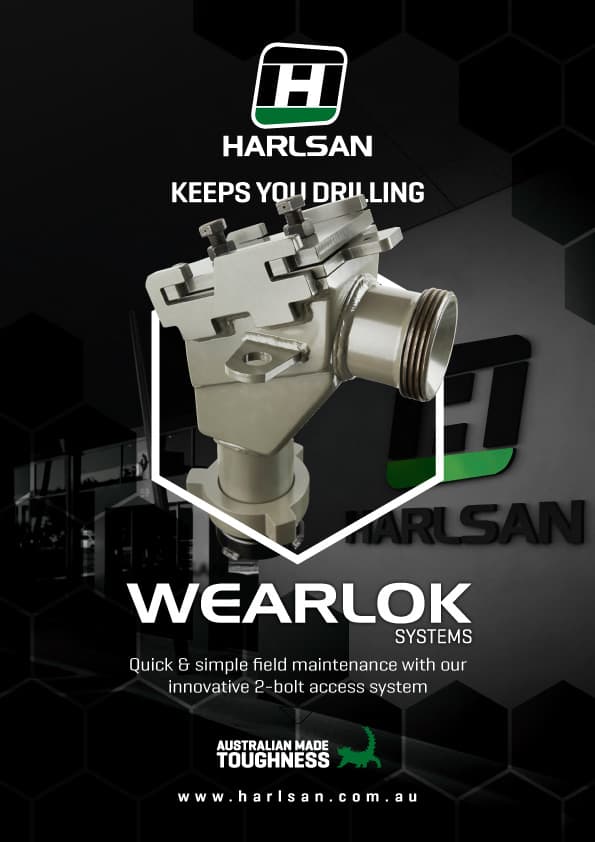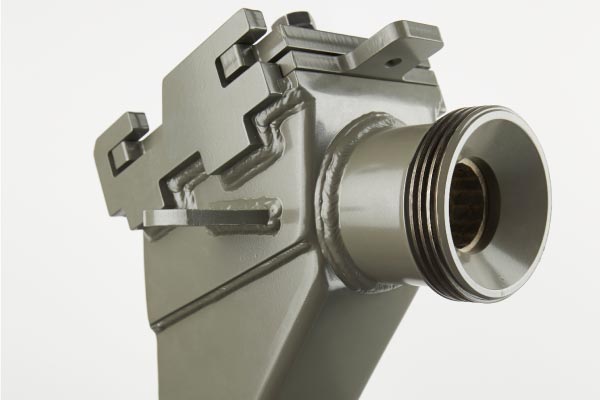Harlsan deflector box wear bend design boosts safety and durability.
Don’t have time to read the full article? Here’s a summary of benefits of the new Harlsan Wear Bend:
- Maintenance intervals up to 5 x longer: The stronger inner core significantly reduces the number of at height maintenance events
- A quarter of the Time Working At Height: Improved access reduces working at height time from 20 minutes to 5 minutes
- Only 2 Bolts to undo: Number of heavy bolts reduced from 10 to 2, reducing risk of dropping or loss
- Access Time cut in half: Simplified internal block design means it can be easily removed requiring less effort and reducing risk of potential strain
- 80% Reduced Maintenance Effort: Increased ease of maintenance means it is more likely to occur in a timely fashion
- 3 x Longer Life: Built more robust, with an innovative form of reinforcement
Harlsan WEARLOK Wear Bend
Without a doubt, regularly maintaining the parts on your rig will increase the life you can expect from your equipment. However, there are some tasks that don’t get done as often as they should or, don’t get done at all. Neglecting regular maintenance can have a detrimental effect on meters drilled per shift by potentially causing unexpected, costly downtimes.
Reverse circulation drill rig deflector box, or wear bend, maintenance is one of those repetitive tasks that often get ignored in the field.
So, what is the root cause of this? Maintaining your wear bend usually requires working at significant heights of up to six metres, involving loose parts, with a simple inspection taking up to 20 minutes to complete.
It is evident that working at heights, for an extended period, with several small, loose parts, presents significant safety risks, with serious potential for personal injury to the person carrying out the inspection, or others standing below.
It is an uncomfortable job, and as a result of these risks and difficulties, many crews aren’t maintaining their deflector boxes with the frequency that they should. Harlsan has set out to change that, to keep clients drilling for longer.
The two main reasons for not carrying out regular inspections or wear bend maintenance are the time-consuming nature of the task, and the safety risks involved.
To solve the issue of irregular wear bend maintenance, Harlsan has developed an innovative new deflector box design that lasts longer, reduces the time it takes to carry out inspections or maintenance and facilitates quick access when it is required.
How quickly can maintenance be carried out on a Harlsan wear bend? We’ve reduced the time it takes to complete maintenance from 20 minutes down to just 5 minutes, making it an easy, pain-free routine task.
Our innovative new design makes it easier for people to do their job which leads to a more positive, predictable result.

What is a Deflector Box/Wear Bend?
The terms deflector box and wear bend are sometimes used interchangeably to refer to the same section of a drill rig. Technically, a wear bend is positioned inside the deflector box on an RC drill rig, high above the drill head.
During drilling, there is a consistent flow of sample traveling through the deflector box wear bends and back down to the ground. The sample flow is as follows:
- Impact: the drill hammer impact breaks up and releases sample from the ground
- Extraction: high-pressure air carries the sample at high speed up to the deflector box at the top of the drill rig
- Redirection: the wear bends inside the deflector box redirect the sample back to the ground via a heavy-duty rubber hose
- Collection: the sample is collected in a cyclone unit where it is spun and the velocity is taken off it.
Wear Bends Need To Be Robust
An RC drill rig will often run two huge compressors with 500 horsepower engines driving them. There is also often a pressure booster too.
Together, this equipment has the potential to generate1,500 cubic feet of air per minute at 1,000 psi.
As a result of this, the sample that the hammer is producing is traveling at very high velocity and is usually very abrasive. The deflector box has to take the full grunt of that energy to redirect sample back down to the ground for collection.
The wear bend is therefore subjected to high impact and high abrasion during drilling, and without regular maintenance will inevitably wear out, to the point of failure.
Awkward High-Risk Maintenance For Conventional Deflector Boxes
Deflector box inspection and maintenance presents challenges to the drill crew. The heights involved are a significant risk. Additionally, traditional deflector boxes are difficult to access, with a large number of bolts securing the box. There is a risk of heavy bolts being dropped from a height on to workers below.
Should a part or bolt be lost during maintenance, if tight drilling schedules are in place there may be a temptation for crews to put the deflector box back into service without adequate fastenings in place, or to skip maintenance entirely.
Building A Stronger Deflector Box
After deciding to manufacture a new version of their deflector box and wear bend design, Harlsan’s priority was to add strength to the inner core of the deflector box to get more life out of it. This would reduce required maintenance events.
Increased inner core strength was achieved by utilising a new, innovative form of reinforcement. This improvement to the wear factor on the main impact area saw one Harlsan mining client increase the amount of drilling between maintenance events from 1,500 metres up to 5,000 metres.
While ground conditions vary from site to site, stronger deflector boxes will almost always deliver more time between scheduled maintenance, leading to more production output, and ultimately to a lower cost per metre drilled.
Innovative Deflector Box Has Key Safety Benefits
The second design priority for Harlsan’s new wear bend, was to simplify the access for maintenance.
Conventional deflector boxes use a large number of bolts. Harlsan have replaced those bolts with a heavy-duty clamping system. This means that instead of having to remove sixteen bolts in a conventional deflector box, a Harlsan deflector box only needs two bolts to be removed.
Furthermore, Harlsan ensured that their wear bend has “inbuilt quality”, ensuring less operator error, simply because the design of the product doesn’t allow you to do anything wrong during maintenance, assembly or disassembly.
This represents a significant reduction in time and effort required to carry out maintenance or an inspection.
Bottom Line Benefit
Harlsan’s innovative deflector boxes offer a longer service life. Firstly, because of the tough Australian made materials used in manufacturing, and secondly because of the ease of maintenance, meaning crews will more frequently maintain and inspect wear bends.
Ensuring regular maintenance gets carried out in an easy, quick manner, will help crews prevent unexpected downtimes and contribute positively towards production schedules being achieved.
Keep Up With Harlsan Product News & Innovation





 Youtube
Youtube LinkedIn
LinkedIn Facebook
Facebook Instagram
Instagram